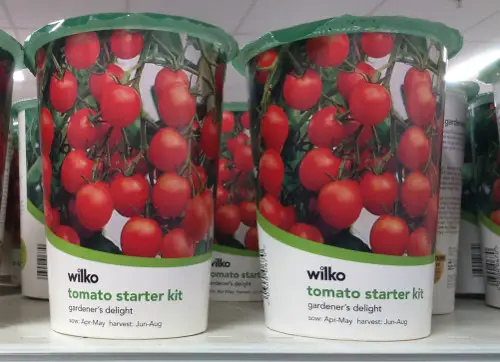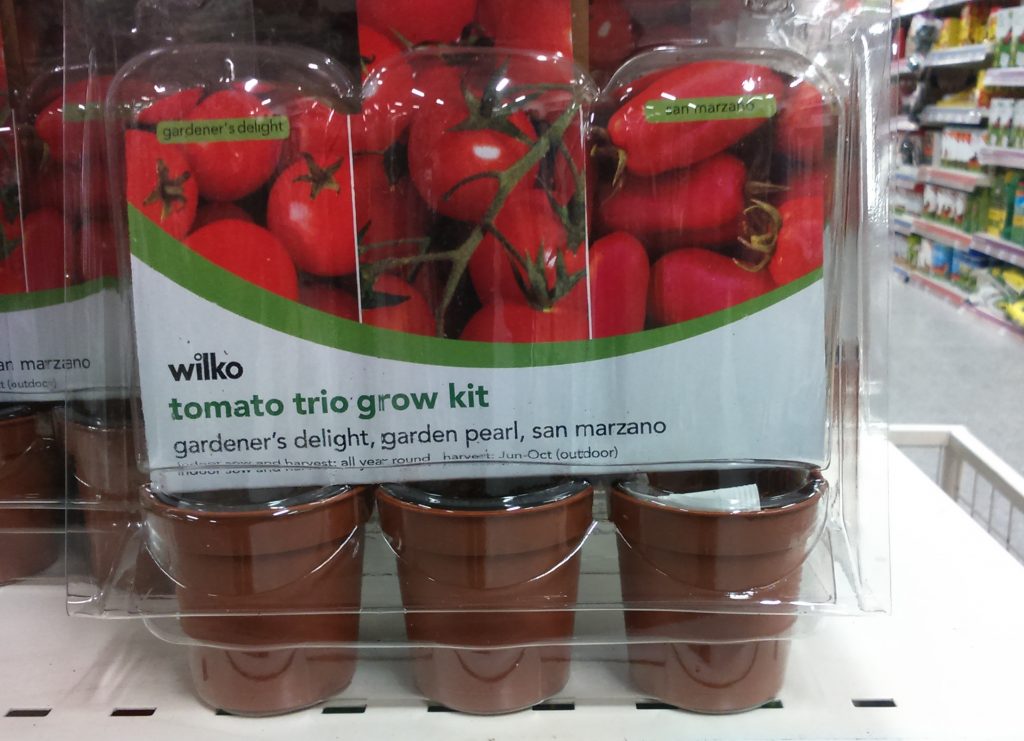Tomato Starter Kits
One of the best places to shop for tomato grow kits and other propagation equipment is Wilco’s, especially if you are looking to get value for money.
This season they have quite a good range in tomato grow kits, so I thought I might pop along to my nearest store and take a photo or two!

The Tomato Starter Kit has been around in the discount stores for some time. It contains a small pack of seeds and the medium is usually coir – coconut shell.
Of course the range of varieties available is very limited – mainly Gardeners’ Delight and Moneymaker, but the pot is a decent size and is fine for sowing three or four seeds. These pots usually have false bottoms so watering from below is a bit hit and miss!
Tomato Grow Kits

The Tomato Trio Kit is a good idea with Gardener’s Delight (Tall Cherry), Garden Pearl (Bush Cherry) and San Marzano (Tall Plum) very fleshy and great for cooking.
The disadvantage of these tomato grow kits is that the pots are very small. Seedlings germinated in these pots would have to been transplanted very soon into bigger pots to provide enough space.

There are also Tomato Pot Grow Kits – similar to the starter kit but larger.

Lastly, there is the Tomato Trough Grow Kit for growing indoors on the windowsill.
A good idea but these troughs are a bit shallow and won’t contain enough compost or coir to support a
dwarf windowsill variety – you really need more depth for best results.
My Thoughts
Overall, if you wish to grow a few Gardener’s Delight or Moneymaker plants this season, buy the starter kit. Sow three or four seeds and after the usual potting up stages, plant the best three into a grow bag later in the season.
My preferred method is to buy seeds, compost and pots separately and choose from the widest range of seed varieties available – literally thousands!
Gardener’s Delight is a fine variety but Sungold, Sweet Aperitif and Black Cherry are three popular varieties that grow just as well as GD and have excellent flavour.
Temperatures for germination and seedlings
These temperatures are ideal and tomato seeds and plants won’t mind some variation – it’s good to have something to aim for though!
Germination
Seed germination (propagation) 18 -21C
After germination
As soon as the seeds germinate – about 5 to 7 days at the above temperatures, put them into a light windowsill or under a grow light.
Day temperatures should be around 18C and night temperatures 12 to 15C
Some varieties can cope better with lower temperatures than others, however, it’s best to keep seedlings above 10C to prevent their growth becoming checked. Steady temperatures equal steady, consistant growth.
Tips to prevent leggy seedlings…
- The higher the temperature the more light needed to prevent legginess
- Over watering can cause seedlings to become leggy
- So, when light levels are low, reduce temperature and avoid over watering!
- Crowding will also cause leggy seedlings as they each compete for available light
- The later you sow in the season, the easier it is to prevent leggy seedlings because days are longer and there is more light
Some varieties are more prone to legginess than others
Dwarf varieties such as Heartbreaker, Sweet ‘n’ Neat, Minibel (available at Wilco’s) and Micro Tom will be OK in lower light levels.
Red Alert and most tall (indeterminate, cordon) varieties will become very leggy in low light levels, such as a warm windowsill on a cloudy day after they’ve just been given plenty of water!
Using a propagator
Propagators are very useful for retaining air humidity as soon as seedlings germinate. The humidy keeps seed shells from becoming hard, this helps the seedling to discard the seed shell.

When this happens, moisten the seed shell then about ten minutes later, gently remove it by hand. A wetting agent added to the water helps the process.
A heated propagator is great for germinating seeds quickly, but you can get the same results if you use a warm airing cupboard.
Make sure that seedlings are removed into a cooler, lighter position as soon as they come through. My airing cupboard used to be around 24C and the first seedling to emerge was usually just four days after sowing!
Once the seedlings are through, the lid of a heated or unheated propagator should be gradually removed because air circulation is important to avoid fungal diseases.
A wetting agent
A tiny drop of washing up liquid in a large bowl of water is all that is needed to break the surface tension of water. You could also put a bar of soap in a bowl of water for a few minutes – that will do too!
In either case, avoid anti-bacterial washing up liquid – we like friendly bacteria in our soil, and use a gentle soap.
Wetting agents are also called surfactants as they break the surface tension of water. Great for rehydrating dry soil too – especially in large containers and grow bags.
Seed Compost and other Media

Two popular seed composts from Westland
What makes a good seed compost?
- A light fluffy mix that will hold both air and moisture.
- Makes it easy to prick out seedlings without losing a lot of the root system.
- Contains the right amount of nutrients and is at the right pH for tomato seedlings.
Some gardeners make up their own mix for their seed compost. A handful of vermiculite, a handful of perlite and the same of multi-purpose compost – seived of course!
Why do that?
- Increasing the amount of moisture and air a medium can hold makes for better growth
- One bag of multi-pupose can be used later in the season for larger plants.
- The stronger nutrient content is reduced by adding perlite and/or vermiculite.
- Saves money – if you already use perlite and vermiculite!
The value of vermiculite and perlite
Some gardeners use vermiculite when covering their seeds for germination.
Perlite is brilliant for adding to composts to help retain air in the soil, as plants are potted on.
A bag of either will last a few seasons if used sparingly.
Seeds can be sown in just vermiculite or perlite if you have a nutrient solution for seedlings – particularly good if you intend to grow your tomatoes hydroponically – without soil or compost in a medium such as rockwool or coir.
Jiffy pellets, sponges, rockwool and hydroponics
Jiffy pellets are de-hydrated coir or peat pellets that expand when water is added. A wetting agent is useful here.
Jiffy pellets have a small amount of nutrients added but sponges need a seedling feed.
Another option is the rockwool cube similar to the sponge. Both the rockwool and the sponge have a lot of moisture holding capacity and air cavities – perfect for growing young seedlings!
Seedlings started in rockwool cubes and sponges often find themselves planted into a rockwool block a few weeks down the road.
Professional growers like this sort of media (growing hydroponically) because they have more control over nutrient application and disease prevention.
Next Week
As well as the newsletter, I intend to start a step by step tutorial on how to grow a dwarf variety on the windowsill. This is an introduction to hydroponic growing which is actually a lot of fun! Details will appear above, at the top of the newsletter page.
Rhys’s New Blog
One of our long-standing newsletter members has just started a new blog called The Nifty Fifty Project at http://urban-no-dig.com/ Rhys is an experienced tomato grower and competion winner!
That’s it for this week … comments and questions below or visit/join our facebook page or group.
Kind Regards,
Nick
Email: [email protected]
Facebook Page: https://www.facebook.com/tomatogrowing/
Facebook Group: https://www.facebook.com/groups/216375252171863/
Links to supplies…
Tomato Seeds, Propagators, Jiffys are available in Wilco, Rootit Sponges, Grow Lights.

Rob
Thank you, Nick. I’ve grown tomatoes for more than fifty years, yet I learn something new with every newsletter. Much appreciated.
Nick
Hi Rob,
Sorry I didn’t get back to you sooner – I’ve only just found your comment.
I’m pleased that you have found the newsletter helpful – it’s amazing how much we can learn about growing a tomato!
Chris
Appreciated Nick. Value these bulletins
Nick
Thanks Chris!